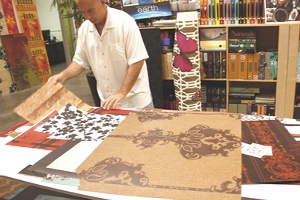Aaron Kirsch knows the meaning of the term “bootstrapping.” When he founded Van Nuys-based Astek Wallcoverings in the early 1980s, local banks refused to finance the wallpaper printing venture. So he turned to the only available source of quick money: credit cards. “As any entrepreneur knows, sometimes we have to take risks,” said Kirsch, president of Astek. “I lived and breathed on my American Express.” He racked-up nearly $100,000 in credit card debt during the company’s early years, he added. But the risk is paying off. Astek generated $8.7 million in revenues in 2008, is profitable, and considered one of the Valley’s fastest growing private companies. And Kirsch has not only paid off that start-up debt, he has gone on to secure multiple sources of conventional financing. Access to capital is crucial for starting, operating and growing a business. Some entrepreneurs solicit the help of family and friends, while others use credit cards, conventional bank financing, or tap millions of dollars from venture capitalists. Regardless, the true test is whether entrepreneurs can turn that capital into a self sustaining and profitable business. Here are a few of the Valley’s fastest growing private companies’ tales. Calabasas-based Fulcrum Microsystems secured start-up funding during the dot-com bubble of the late 1990s and early 2000s. Founders, Andrew Lines and Uri Cummings, had little more than a raw idea for a semiconductor business. But they managed to raise $6 million in seed capital from a handful of tech industry veterans in early 2000. “Back then there were people with lots of money and excitement,” said Fulcrum CEO, Bob Nunn, who joined the company in 2001. “People were getting funded when maybe they shouldn’t have been.” Six million dollars is a lot of money even for a start-up today, he added. Nunn joined the company to secure “sophisticated” venture capital out of the Bay Area. Shortly thereafter, Fulcrum landed a Series A round of venture capital, worth $14 million, from New Enterprise Associates and two other VC firms. Too expensive By 2003, however, access to capital was a lot tougher. Despite having a defined technology and product plan, numerous investment firms told the company it was too expensive to fund at the time. So Fulcrum killed its original product idea and set out on a new track. It managed to secure a restructuring round of capital, a Series C in 2005 and additional rounds. The chip maker has raised a total of $102 million in five rounds, not including the $6 million seed funding. Tapping venture capital makes a very definite statement, said Nunn. “Once you start down this path you’re really committed,” he said. “VCs are expecting you to build a substantial entity, because they’re looking for a big win. VCs want a 10x exit.” Emmy-winning writer, producer and actor, Dave Thomas, and partner, Andrew Bain, founded Animax Entertainment in 2001. The Van Nuys-based firm helps clients create animated virtual worlds, online games, web sites and more. The duo funded the start-up out of pocket. In the company’s early years, they also used labor from outside the U.S. to keep costs down and speed up turnaround time on projects, according to Animax CEO, Corey Torrence. From 2006 to 2008, the company’s revenues grew 584 percent. Torrence attributes this growth to Dave Thomas’ comedic storytelling as it relates to digital media; Animax having a couple big hits with creating virtual worlds for Beanie Babies and Ty Girls; the former CEO establishing more structure and expanding the company’s accounts; and building “re-skinnable” technologies. But the company is at a crossroads, he said. “Getting to the next level can’t be done on the heels of (these guys) making the magic happen. I have been working with the team to figure out a scalable model. We need to re-cap the business.” Torrence, who joined the company in Jan. 2009, is approaching venture capital firms for an initial $15 million round of financing. And the company hired a public relations firm to expand its presence in the industry and media. The quest for capital was disheartening in Jan., Feb. and March of this year, he said, because very few firms were investing. But in the past six months, chances of securing venture capital have looked a lot more promising. “We have on-going talks with six serious investors and we have two term sheets,” said Torrence. “Compared to not even a year ago, deals are coming to us without me having to ask.” Aaron Kirsch of Astek Wallcoverings said securing financing is only half the battle. Investing money wisely is the biggest challenge. He invested a large amount of capital into leasing three cutting-edge printers worth about $500,000 each. A risky move, but the printers have reduced costs, boosted the company’s creative identity, and there are tax benefits to leasing. He also launched a web site that has turned into an inexpensive source of revenue. Additionally, Kirsch pounds the pavement by taking products to multiple trade shows throughout the year. He sinks most of the profits right back into the company. “You have to make sure you use your financial instruments wisely,” he said. “And, you can’t drain the business…you have to feed the beast.”
